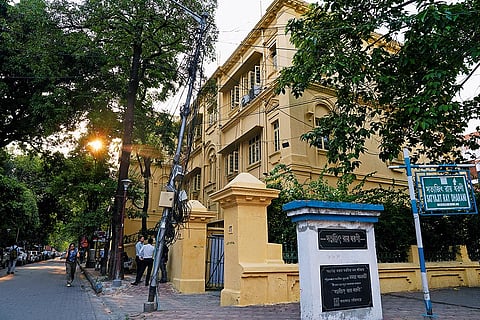
- Destinations
- Experiences
- Stay
- What's new
- Celebrating People
- Responsible Tourism
- CampaignsCampaigns
- Subscribe
- Buy Now

Women cinegoers who are in their sixties today would remember a time when they were torn between two of the most celebrated matinee idols of Bengali cinema in their 20s. The phrase matinee idol itself is obsolete in this age of OTT binge-ing. It harks back to the era when matinee (3 pm) shows at cinema halls would make or break a cine star.
There would be two teams of fans, one backing actor-director-screenwriter-composer-playback singer Uttam Kumar, whose career spanned over three decades from the late 40s to his death in 1980, and another cheering on Soumitra Chatterjee, a playwright, play director, writer, poet and film star known for his stellar peformances in Satyajit Ray films like "Apur Sansar" (1959) and "Shakha Prashakha" (1990).
On July 24, 1980, Kumar had a fatal heart attack when he was only 53. The press carried stories of how, after having felt discomfort at the Moira Street flat, Kumar had walked over to Belle Vue, a nursing home, a stone's throw away. When the news broke, it seemed as if the whole of Kolkata was struck with an intense grief. His fans lined the streets from his Moira Street residence to his ancestral Bhawanipore home to the crematorium.
All these memories come back in a flash when browsing through Bengal Film Archive (BFA)'s website. It is an archive of important and often neglected nuggets of information, photographs, detailed filmography from the talkies to the 2000s, short biographies of stars, directors, technicians, musicians, stories of cinema houses, studios, distribution houses and laboratories. It is an exhaustive, virtual repository of Tollywood, as the Bengali film industry is often called.
Team BFA is a collective of film enthusiasts from different walks of life who share a passion for films. The team put together the archive during COVID-19 as it felt "there was insufficient effort to preserve our heritage."
"We often cherish nostalgia but neglect to protect what we celebrate. During the pandemic, with uncertainty around us, we film enthusiasts realised that preserving Bengal’s cinematic legacy wouldn’t be a priority for many. Even as COVID-19 threatened our own survival, we continued to pursue the dream of preserving what we could, despite limited resources," said the team in an email interview.
"This archive is a continuous project, updated slowly with small pieces of information. We proceed carefully to avoid archiving misinformation, thoroughly verifying oral history before adding it. It’s a time-consuming process, but we’re in no rush. We’re not focused on numbers or proving anything to anyone," said the spokesperson.
Among the various sections in BFA, the "House of Memories" stands out. Here the archivists have uploaded pictures of houses where Bengal's cine stars resided. Kumar's original residence was in Bhawanipore, where he had got married and where his first wife, Gouri Devi had lived and died. It is where his extended family, including his younger brother, Tarun Kumar, also a cine star, lived with his star wife, Subrata Chatterjee.
Named Girish Dham on Girish Chandra Road, the multistoried, art deco house stands spick and span today. It is inhabited by Kumar's descendants and is open to the public on his birth and death anniversaries. On the website there is a grainy shot of Kumar in a suit standing on the long verandah of the house.
Among the BFA archive’s collection is a photo of the Moira Street house where film icon Supriya Devi lived with her daughter and partner Uttam Kumar. The Moira Street flat belonged to Devi, another stalwart of Bengali cinema with whom Kumar moved in later in his life.
Bishop Lefroy Road, where Ray lived, has become a pilgrimage of sorts. Visitors to Kolkata, including the Who's Who of the celluloid world and beyond, drop in to feel the aura of Ray in his celebrated study lined with books and characterised by the swivel chair behind the huge desk piled with books and bric-a-brac. Even German filmmaker Wim Wenders visited the house on his recent India tour. Ray's son, Sandip Ray, continues to live there with his family.
Most homes of Bengal’s film legends have vanished or changed beyond recognition. Ajoy Kar’s former residence is now a jewellery store, and Amar Chowdhury’s house is a crumbling structure marked "dangerous" by the Kolkata Municipal Corporation. While blue plaques nod to heritage, true restoration remains neglected.
However, there is much to conserve apart from the "House of Memories." And BFA does that meticulously by presenting detailed filmography starting right from the silent era "Raja Harish Chandra" with its black and white print ad to "Shankha Sindoorer Dibyi" of the 1990s. Film names with director, crew, date of release and the halls where the films ran, have been documented.
Just like "House of Memories," the "Then and Now" section of the BFA archive juxtaposes iconic film locations with their present-day counterparts. For example, Ray’s "Pather Panchali" (1955) was shot in Boral village, near Kolkata. While the twin Shiva temples where Harihar (the patriarch of the family) pauses in the film remain, the spot where Chunibala Devi (the lovable old grandaunt of Durga) stood before a tulsi mancha (tulsi plant in a homestead) has changed beyond recognition. Similarly, the house at Patuatala Lane, where teenage Apu, the central character, stands in "Aparajito," (1956) still exists.
This April 15, BFA turned three and celebrated by releasing Youtube videos where they recognise the contributions of Ranabir Das’s cinematography in "All We Imagine As Light," Debajyoti Ghosh’s colour grading in "Mayanagar," Abhro Banerjee’s editing in "Manikbabur Megh" and the title montage by Abhijit Chowdhury and Ayandeep Chakroborty in "Dhrubor Aschorjo Jibon."
